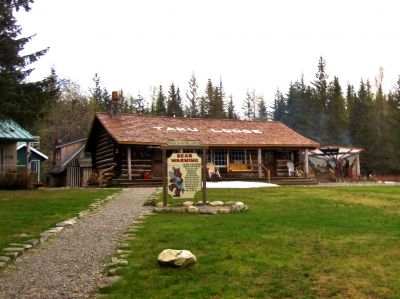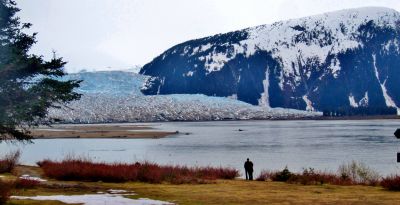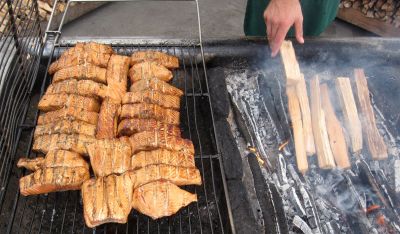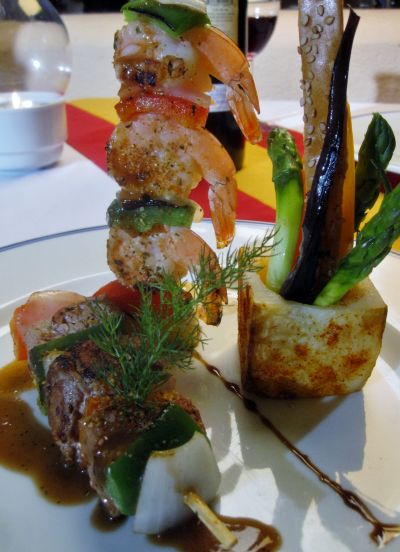
Viewing entries tagged food

By Will McGough
Will McGough
I could tell you a few things: I'm a writer, I live in Santa Barbara, and I'm an
User is currently offline
| Wednesday, 19 September 2012
|
Comments
|
Subscribe to updates
I wanted to extend a congratulations to the chef and staff at the King and Prince Resort for winning the people's choice award at the 2012 Wild Georgia Shrimp & Grits Festival on Jekyll Island this past weekend. I visited St. Simons and stayed at the King and Prince for a few days last spring to attend a Georgia culinary tour, and I got to know Chef Jeff Kaplan and crew over the course of my stay. Kaplan is new to the hotel - he was in his first week when I visited in April - and it looks like he's off to a damn good start.
-

-
King and Prince Resort, St. Simons, Georgia
For those of you who have never been, St. Simons is a great place for a relaxing, slow-paced getaway. It's not too late for a visit this year, as temperatures remain comfortable with highs in the 70s well into November. You can read about my adventures eating my way through the island, from the sweet Georgia shrimp of the King and Prince to the highly-regarded Southern Soul Barbecue. Georgia shrimp are probably the best I've ever had - they are truly sweeter than those from other regions - and when I went out on a shrimping boat to catch a few, I ended up catching a lot more than just shrimp.
As someone who has personally tasted and enjoyed his take on the infamous southern staple, I wanted to pass on the recipe for Chef Kaplan's winning dish, prepared as a breakfast side or as a main dinner entree as the weather begins to cool down. That heavy cream does the trick, for sure.
SHRIMP & GRITS WITH TASSO CREAM SAUCE
Makes 2 Servings
1 cup heavy cream
3 T. olive oil
1/3 cup Tasso Ham
¼ cup Kernel Corn
¼ cup Diced Tomatoes
2 T. chopped Green Onion
½ cup Wild Georgia Shrimp
1 T. Cajun Seasoning
¼ cup Asiago Cheese
Salt & Pepper to Taste
In one saucepan, sauté the shrimp with Cajun seasoning using olive oil. In another pan, sauté the ham, corn, tomatoes and green onions. Add heavy cream and Asiago cheese; let simmer for two minutes. Add shrimp and serve over stone ground grits of your choice.
-

-
King and Prince Resort, St. Simons, Georgia
-

-
King and Prince Resort, St. Simons, Georgia
-

-
King and Prince Resort, St. Simons, Georgia
-

-
King and Prince Resort, St. Simons, Georgia
-

-
Yours truly helping to prepare the shrimp and grits at King and Prince Resort, St. Simons, Georgia
-

-
Shrimp and Grits at the King and Prince Resort, St. Simons, Georgia
-

-
Yours truly with a shark aboard the Lady Jane in St. Simons, Georgia.

By Will McGough
Will McGough
I could tell you a few things: I'm a writer, I live in Santa Barbara, and I'm an
User is currently offline
| Wednesday, 08 August 2012
|
Comments
|
Subscribe to updates
When I entered the neighborhood known as German Village just south of downtown Columbus, the first thing I noticed was the colonial feel, the abundance of brick that made up the houses and sidewalks.
-

-
Berry pie at Harvest Pizzeria.
There's no grass, but small green trees separate the red-brick sidewalks from the cast-iron fences on one side and the gray-brick street on the other. On the sides of the streets I could see white-rock carriage steps, a reminder of early days when the houses would all have horses tied out in front.
The name results from its settlement by German immigrants during the 19th century, very much in the same way they settled the Over-the-Rhine neighborhood in Cincinnati. It's a great part of the city to walk in, very peaceful and very suburban, with an average home price of $377,000, several of which are over $1 million. No surprise, the clientele of this area has drawn some of Columbus' best restaurants to the neighborhood. Here are a few places I would recommend, all of which are on board with the farm-to-fork movement:
-

-
Margarita pizza at Harvest.
Harvest Pizzeria and Curio: There is so much mediocre pizza out there, but most of us don't care because pizza is pizza, and even when it isn't great, it's still good. Many of the gems you'll find in big cities don't offer comfortable seating, and the suburban establishments are typically more focused on delivery and high-quantity production than detailed construction. Harvest Pizza excels in both areas: They made great thin-crust pizza, and they recently unveiled an old-fashioned cocktail bar called Curio.
There aren't many places you can eat pizza and sip speakeasy cocktails - I sampled pieces of Margarita, mushroom, and double-bacon pizza while enjoying a Hickory Stick Bourbon drink with Fernet Branca, vermouth, bitters, and liquid smoke. Decorated with throwback items such as a large, gold and old cash register, suspended top hats, and bartenders who meticulously mix drinks, this is easily the most unique pizza joint I've stumbled upon in recent memory. Be sure to check it out for a happy hour that leads into dinner, and save room for the dessert. Two recommendations: The Butterscotch Budino (it's like a butterscotch pudding with caramel sauce, creme fraiche, toasted hazelnuts, vanilla-scented Maldon sea salt) or the pie of the day, made by none other than the owner's mother (seriously, see photo).
-

-
Jumbo scallops at G Michaels.
Photo courtesy G Michaels.
G. Michaels: It's "restaurant week" every week at G. Michaels in German Village, the chef offering a 3-course meal every Monday for $30. We were treated to a five-course tasting menu paired with the beers from Rockmill Brewery, sampling the scallops with wilted arugula, corn, and mushrooms, salmon with blue-cheese potato gratin and a caramelized-onion sauce, shrimp and grits, bacon-wrapped venison, and a vanilla-infused Panna Cotta with melons and gorgonzola.
I'm a big fan of tasting menus as they give a good perspective and overview of what the chef and the restaurant have to offer. It puts the pressure on to exceed over the "course" of the meal - not just one dish - and G. Michaels impressed with its wide range of well-executed concepts. I thought the blue-cheese potato gratin was a delicious twist and perfect compliment to the sweetness of the caramelized onions, and the gorgonzola with the melons and Panna Cotta was a sneaky/brilliant way to construct the sweet/salt/savory combo that we all crave in a fruit/cheese pairing.
Skillet: The menu is constantly changing at this popular weekend brunch spot, always seasonally driven and dependent upon "what comes through the door that morning," Chef Kevin Caskey explained. Do not hesitate if you see the blackberry pancakes on the menu - I found the fruit to be sweet enough that many bites did not need syrup. Next time I think I'm going to try the Smoked Duck Quesadilla if they have it: Shredded smoked duck and blistered sweet vidalias folded into a grilled tortilla with queso chihuahua, chile verde, and toasted pepitas served with charro beans.
They don't take reservations, so get there early on Saturday or Sunday (open 8 a.m. to 2 p.m.) for large portions of "rustic urban food" served up in a small venue. Caskey describes his food as ingredient driven, simple, and never complicated, and I found a quote that I love about the food at Skillet: It is deceptively simple, like the painting on the wall that everyone thinks they can paint... until they try.
Photos:
-

-
Dining area/bar at G Michaels. Photo courtesy G Michaels.
-

-
The streets of German Village, Columbus.
-

-
German Village, Columbus.
-

-
German Village, Columbus.

By Will McGough
Will McGough
I could tell you a few things: I'm a writer, I live in Santa Barbara, and I'm an
User is currently offline
| Tuesday, 07 August 2012
|
Comments
|
Subscribe to updates
We (travel writers) are so focused on what is good for outsiders coming in that I think sometimes we lose sight of how important certain developments are for those that actually live in the place we’re exploring. I was invited to Columbus to give my thoughts on the food scene – to talk about it in terms of travel – but I think I’m going to put that on hold for a moment, take a step back. One of my main inspirations and reasons for travel is to see the way in which other people choose to live their lives, and I think this is a good time for a quick reflection.
-

-
Columbus celebrated its 200th birthday this year.
I think sometimes cities and countries are so focused on trying to attract big, broad business that they forget to embrace the personalities of their residents.
Unfortunately, most people are vacationers, not travelers, and familiar names are a welcome sight. Take a majority of the world’s cruise-ship ports, Times Square, Fisherman’s Wharf, or Inner Harbor, for example. Tourists will find things to entertain themselves and you can have a good time in these locations, but they are far from an accurate depiction of local personality, far from why residents opt to live in each respective city.
My advice to Columbus (and other cities in similar up-and-coming situations without established tourism) would be to be selfish first and foremost, focus on things about which your people are passionate. If you build something with charm and personality that is a reflection of your residents, travelers such as myself will be attracted to that culture. While developing an area with chain restaurants and brands recognizable to outsiders might bring short-term success and higher profits, being true to local products/personality is what will generate growth and inspire from within. Most importantly and above all else, it will generatea great city as opposed to a great place to spend a few days.
 During my time in Columbus, I found those in the business of booze to more than understand this concept. We visited Brother’s Drake in celebration of National Mead Day on Saturday (it’s always the first Saturday in August). Mead is a beverage similar to wine made from water, honey, and spices, and its consumption/production dates back to 7000 BC (that's a long time ago, man). During my time in Columbus, I found those in the business of booze to more than understand this concept. We visited Brother’s Drake in celebration of National Mead Day on Saturday (it’s always the first Saturday in August). Mead is a beverage similar to wine made from water, honey, and spices, and its consumption/production dates back to 7000 BC (that's a long time ago, man).
Owner Oron Benary explained how he plans to keep the business local, and he isn’t afraid to express his disdain for big business’ obsession with the bottom line. He’s focused on earning a livable wage via his craft, he said, not maximizing profit. Other beliefs: Employees should be paid living wage, not minimum, and he believes the pollution produced in shipping something from out of the country is worth no break in price, no increase in profits. The fruits of a local product (both the mead itself and the profit from its sales) that is produced by local labor and ingredients should stay local, he said.
In a world full of corporate structures and classrooms that teach the youth that the bottom line is king, I found this mindset to be refreshing. And whereas it’s often cheaper for businesses to buy new rather than reuse assets, I was happy to observe the strong connection between the local businesses in Columbus. There are tons of examples: Middle West Spirits ages whiskey in oak barrels, then sends the empties to Rockmill Brewery to cask-age their tripel; Rockmill Brewery sends beer to Jeni’s to make ice cream flavors; Brother’s Drake refuses to ship out of Columbus, not even to Cincinnati or Cleveland.
 As it was in Detroit and Cincinnati, a rebuilding Columbus is an excellent place for entrepreneurs. To reuse a quote from my trip to Detroit that I believe applies here, you can’t afford to be a struggling start-up long in cities like New York, D.C., or Los Angeles, but you can in cities that are currently getting their swagger back. As it was in Detroit and Cincinnati, a rebuilding Columbus is an excellent place for entrepreneurs. To reuse a quote from my trip to Detroit that I believe applies here, you can’t afford to be a struggling start-up long in cities like New York, D.C., or Los Angeles, but you can in cities that are currently getting their swagger back.
Here are a few companies to check out when you find yourself thirsty in Columbus:
Watershed Distillery: I told you that I had a nice time playing drinking games and sampling some damn-good gin. Read up here if you haven’t yet, and look for it behind the bar in the mid-west.
Middle West Spirits: The OYO label consists of whiskeys and vodkas, the latter of an unfiltered variety. We did a side-by-side tasting of OYO vodka and Grey Goose during my visit, highlighting the difference between a vodka that's been filtered and one that has not (filtering the vodka removes a lot of the character from the grains and gives it a broader appeal, and the point of the tasting was to show the two different styles). Middle West believes (rightfully so) that unfiltered vodka carries the taste of the region's grain. In this case, Ohio's comes through rather pleasantly, and although I love Grey Goose, I dig the concept of the local vodkas representing the bite of the local soil.
Rockmill Brewery: The story behind Saison, or the farmhouse ale, is that it was invented by Belgian farmers who realized that an ale is easy to produce and store, as well as an excellent calorie provider/motivator for workers out in the field. Rockmill carries on this tradition today with a tasty version of its own, but my favorite was the cask-aged tripel that grows old in a whiskey barrel from Middle West Spirits. I put a bottle in my checked bag and, despite some concern, it made it safe and sound, sin explosion.
The scoop on the Columbus dining scene is on the way.

By Will McGough
Will McGough
I could tell you a few things: I'm a writer, I live in Santa Barbara, and I'm an
User is currently offline
| Thursday, 02 August 2012
|
Comments
|
Subscribe to updates
I'm in route from Denver to Columbus to meet up with some foodies and travel writers, the group of us descending upon the city for a culinary-themed weekend to conduct some investigative reporting.
-

-
Columbus skyline courtesy of Rod Berry and Experience Columbus.
Columbus claims it has become a terrific food town - a proclamation that I will admit comes as a surprise to me, as I’m sure it does to many of you. I’ve asked around and there seems to be a buzz brewing, though, the town’s restaurants drawing favorable reviews from fellow travel writers in addition to the woman currently sitting next to me on the plane (who is a frequent visitor).
It just goes to show how important it is to always keep an open mind, to be willing to forgo your expectations and previously held notions, to venture into the unknown in order to discover treasures of travel of which you were previously unaware.
Quick historical perspective: The largest city in Ohio turned 200 this past February, although Columbus is a baby when you stack it against other cities in America. St. Augustine in Florida, the oldest continuously inhabited city in the United States, was founded almost 300 years before Columbus in 1565 (Jamestown and Santa Fe come in at #2 with founding dates of 1607).
I confirmed yesterday that I’ll be headed back to Colorado later this month to do a few stories on the abundance of microbreweries popping up all over the state, but for now, adios Denver. The feast will begin tonight in Columbus, stay tuned.

By Will McGough
Will McGough
I could tell you a few things: I'm a writer, I live in Santa Barbara, and I'm an
User is currently offline
| Wednesday, 01 August 2012
|
Comments
|
Subscribe to updates
A couple weeks ago, I watched the documentary Food Inc., and now I'm all messed up in the head.
-

-
Root Down in Denver, Colorado.
Backstory: I was a vegetarian for five years throughout my late teens and early twenties, the initiative ignited when I learned about factory farming and the disgusting disrespect for animals throughout the process. I didn't really have a plan, I just stopped eating red meat and poultry indefinitely. The longer I went, the better I felt. The more I learned, the less interest I had in returning to my old habits.
Eventually, though, the same problems caught up with me that people struggle with every day - ones laid out in the Food Inc. documentary. We live in a weird world, one whose food industry fosters the illogical reality where a burger and fries is cheaper than a salad. It was not only expensive to be a vegetarian, it was exhausting at times, and I suppose I just ran out of gas, preferring the simplicity of packing a turkey sandwich that would fuel a 10-hour work day to the creative process that constructing a vegetarian meal can become. I still kept the healthy habits I had learned from the experience, but I was back on the sauce, so to speak.
Any thoughts I had of returning to the veggie-lifestyle were erased when I got into travel writing. There is no doubt a niche out there for vegetarian eating when it comes to travel, but my thoughts were (and still are) that it would limit me in my writing, in my quest to experience all the world has to offer. You can't exactly say no to barbecue in the south, salmon in Alaska, or gumbo in New Orleans and expect to get the full flavor of the area.
 Watching Food Inc. (and similar documentaries) is healthy because it tells you things you already know but don't want to think about: Where the food in your grocery store comes from, how it's grown and/or processed, the effects of its production on your health, how those who have benefited from large-scale food production were appointed to government positions by lawmakers, etc. Watching Food Inc. (and similar documentaries) is healthy because it tells you things you already know but don't want to think about: Where the food in your grocery store comes from, how it's grown and/or processed, the effects of its production on your health, how those who have benefited from large-scale food production were appointed to government positions by lawmakers, etc.
I used to joke with people who shopped at farmer's markets by asking them if they enjoyed overpaying for produce, and now I'm going to do everyone a favor and willingly stick my foot in my mouth. I don't expect anyone to uproot their lives overnight, however I do think we all need to take a look at our habits and analyze the behavior of industries that our dollar will end up supporting and reinforcing.
There is currently a big farm-to-fork movement in Colorado (and in other cities across the country), and I think the support for this concept is something we can all agree on, both as travelers and locals. Does the restaurant do its best to buy ingredients from local suppliers and farmers? If nothing else, this is a good starting point for everyday consumers - choosing restaurants that support organic, ethical food production.
-

-
The space Root Down now occupies was formerly a gas station.
Last night I went to such an establishment in the Highlands called Root Down. Owner Justin Cucci believes the greenest thing is something that already exists, a mindset that is immediately backed up by the restaurant's location in a space formerly occupied by a gas station. Whatever produce and herbs they don't get from their on-site garden is purchased from farms throughout Denver, and they even give a shout out to their local suppliers on the menu and constantly update the "organic percentage" of the food they offer. It was 75% when I went, and I appreciate the hell out of the transparency.
Veggie-burger sliders, mussels in a Thai red curry sauce, sun-dried tomato pizzetta with prosciutto and pineapple, and organic sweet potato fries with lime curry sauce were our choices from the rock-solid happy hour menu. Cocktails that are typically $9-$10 will run you $5 from 4:30 - 7 p.m., Monday through Friday.
Those dishes, along with this rant, serve as an appetizer for my culinary adventure to Columbus, which I will preview tomorrow. Hope you're hungry - lots of food chatter on the way.
-

-
The space Root Down now occupies was formerly a gas station.

By Will McGough
Will McGough
I could tell you a few things: I'm a writer, I live in Santa Barbara, and I'm an
User is currently offline
| Monday, 30 July 2012
|
Comments
|
Subscribe to updates
My relationship with traditional Italian restaurants over the years has been constantly conflicted by my Italian upbringing, one in which my grandmother and mother would have simultaneous heart attacks if they found out I went to a restaurant for spaghetti, ravioli, or gnocchi.
-

-
Carbonara Piadina at Panzano.
Fact: A man from an Italian family is never going to have anything better than a mediocre experience at a family-style Italian-ish restaurant, plain and simple. I know I'm not alone in bearing this cross - millions of people endure the suffering that stems from a culinary-endowed family tree. I'm being a smartass, but it's true: Sometimes our mamas just spoil us, and for years I passed on opportunities to dine out at Italian restaurants. Why spend the money when it's better at home?
Contemporary Italian food has really allowed me to start venturing back out to the tables, however, as going out for Italian no longer means putting a stranger's version of gravy up against the family brand. Restaurants now seek to build off and transform the traditional recipes, creating new flavors and well-presented, colorful dishes. A quick side-by-side look at the traditional bowl of spaghetti and today's pasta plates clearly shows the great differences between "now" and "then," see some examples below.
Interestingly enough (although completely coincidental), my two most recent contemporary Italian meals were both in downtown Denver. Back in April, I enjoyed the award-winning egg ravioli at Prima Restorante in the Hotel Teatro, and last Thursday I decided to give its competition a chance - Panzano in the Hotel Monaco.
Executive Chef Elise Wiggins was also spoiled by her mother, growing up in Louisiana eating gumbo and later attending the Colorado Institute of Art in Denver. After stints in Central America and Puerto Rico (where the restaurant received a AAA Four Diamond award during her tenure), she returned to Denver in 2004 and started at Panzano. Wiggins was unfortunately out of the restaurant when I visited last Thursday, but from the chef's table I was able to take in all of her beautiful dishes.
-

-
Mascarpone Cannoli with blueberry compote. Photo credit Laurie Smith.
While some chef's tables can be private or secluded, sitting at the one in Panzano is as if you were sitting at the bar of a nice restaurant, except instead of seeing liquor bottles, you see the chefs preparing every meal. They're approachable and willing to answer questions about what they're making - an awesome perk - and the visual experience kept my attention the entire night. I could see all phases of the process - pasta put into the water, a fried egg placed on the Carbonara Piadina - and the sight, smell, and sound of the preparation was an appetizer in itself.
Assistant General Manager and Wine Director Jason Gordon helped us to pair each course with a glass of wine (a 3-glass flight will run you $16), and the list features many “Tre Bicchieri” award winners from Italy. It was somewhat of an education for me, sampling glasses ofLambrusco, Chianti, and Brachetto.
For $55 a person, you can enjoy a 5-course tasting menu that changes each night. Whatever you decide to order, I would recommend requesting a seat at the chef's table (it is open to everyone and is no extra charge) and settling in for a slow-paced meal. It is in this sense that the old-school Italian traditions are revealed amongst the contemporary cuisine: Many courses, good wine, and long conversation with great food at the heart of the evening.
I'll have more on Panzano in an upcoming Famtripper.com feature - for now, enjoy these photos from the restaurant in downtown Denver:
-

-
A line chef prepares a flat bread appetizer at Panzano. Photo credit Laurie Smith.
-

-
Those sitting at the chef's table are able to watch as the dishes are cooked and constructed. Photo credit Laurie Smith.
-

-
Mascarpone Cannoli with blueberry compote. Photo credit Laurie Smith.
-

-
Capesante at Panzano. Photo credit Jennifer Koskinen.
-

-
Tagliatelle at Panzano. Photo credit Jennifer Koskinen.
-

-
View of the kitchen with the chef's table to the right. photo credit Jennifer Koskinen.
-

-
Brussels sprouts at Panzano. Photo credit Jennifer Koskinen.
-

-
Agnello con fagioli at Panzano. Photo credit Marc Piscotty.
-

-
Carbonara Piadina at Panzano. Photo credit Laurie Smith.

By Will McGough
Will McGough
I could tell you a few things: I'm a writer, I live in Santa Barbara, and I'm an
User is currently offline
| Tuesday, 29 May 2012
|
Comments
|
Subscribe to updates
We were in the sky when I had my first shock and awe moment, flying over a glacier in route from Juneau to Taku Lodge. It was a small, 12-seater seaplane and from the window I could see the pools of blue water on top of the white snow. It relaxed my lower jaw and forced me to push my sunglasses to the top of my head - the color I was seeing couldn't possibly exist.
-

-
Glacier blue water near Taku, Alaska.
You'll see it in the photos below - that ridiculous blue - so unlike any other shade of my favorite color. Don't think sky blue or Caribbean blue, this is glacier blue, a category of its own. It symbolizes such a fresh and pure quality - I think that's what draws me to the color blue in the first place. It is an instigator of deep breaths, for sure, and I looked over at my friends in disbelief.
It certainly didn't take long to be blown away in Alaska. An hour earlier our ship (Royal Caribbean's Rhapsody of the Seas) had docked in Juneau, one of only two ways to access the state's capitol. It's either by boat or by plane - there are no roads into or out of the city - it's located in a channel and surrounded by mountains. Later in the day we would take in the city and go for a local hike, but first a prearranged excursion to Taku Glacier Lodge to have a look at the wilderness and sample some Alaskan salmon.
Upon landing on the Taku river (which feels about the same as landing on concrete, although the view out the window is much better) and arriving at the lodge, I sat on a swinging bench on the front porch, looking out over the water, the glacier coming down the mountain to my left. I could see the blue tint in the glacier - the frozen block of ice clearly could not be described as being plain white. Readers in the northern part of America should not picture the snow in their backyards - this was different (the ice is frozen so solid that it pushes out all the oxygen. When light enters it creates a prism, producing the blue hue).
-

-
Taku Glacier Lodge near Juneau, Alaska
Because of the grilling of the salmon, the lodge is known to attract bears - apparently they are routinely spotted at the nearby edge of the woods, curiously smelling the air. We were not so lucky as to have a sighting that day, although I would get my wish the following day in Skagway (see photo on Facebook).
I can now see why the bears come calling: Not only was the salmon delicious (along with the baked beans, herb biscuits, apple compote, and ginger cookies), but could you ask for a better setting? Sitting in a lodge in the Alaskan wilderness beside a glacier, eating grilled salmon that was caught from local waters, looking out the window and seeing the seaplanes land on the river, the lower green vegetation leading up to the snow-capped peaks of the mountains. Throw in an Alaskan Amber and check back on me in a couple hours, please.
While at first I pondered whether the idea of an organized seaplane excursion to a salmon feast alongside a glacier was too touristy of an activity, just writing the first part of this sentence makes me laugh. Really? That scene described above seems "too touristy," Will?
Yikes. This is what happens when you start getting a little travel under your belt: The jaded perceptions try to sneak into your brain. I think it's important to catch yourself in those moments and realize how incredibly crazy that notion is. When I was boarding the Rhapsody of the Seas a few days earlier, a couple told me they had waited 35 years to take this trip. And meanwhile I was wondering if such an opportunity was too touristy? Good lord.
Not everything has to be rocket science - sometimes the masses lead you in the proper direction. Take this Feast and Flight journey with confidence. For those on a tighter budget, you can take the Glacier Express Blue Bus to Mendenhall Glacier ($16 round trip). When you tire of the jewelry and novelty shops that are abundant in downtown Juneau, walk up to the top of Franklin Street and take a hike through parts of Tongass National Forest (they have built a nice "boardwalk" through the forest and there are plenty of waterfalls. Ask a local for directions as you must wind your way through a neighborhood to access it... 15-20 minute walk from downtown).
Photos:
Juneau, Alaska
Taku Glacier
Alaskan King salmon.
Glacier as viewed from seaplane.
Seaplane outside of Taku Glacier Lodge.
View of a glacier from the seaplane.
Taku Glacier
Taku Glacier as seen from seaplane.
Glacier blue.
Yours truly standing alongside our seaplane.

By Will McGough
Will McGough
I could tell you a few things: I'm a writer, I live in Santa Barbara, and I'm an
User is currently offline
| Thursday, 17 May 2012
|
Comments
|
Subscribe to updates
When I stopped by the New Orleans Convention and Visitors Bureau to pick up a packet, I asked the lady in the shipping and receiving department where she would go in the neighborhood for lunch if she was hungry for some of the famous local fare: Po' boys and gumbo.
 She told me to cross the street and check outThe Trolley Stop, located right along the Charles Avenue trolley line. It has that hole-in-the-wall feeling down pat, very modest looking and friendly service that treats you more like a friend than a customer (they love to use the word 'baby,' as in, Whatcha need, baby?). She told me to cross the street and check outThe Trolley Stop, located right along the Charles Avenue trolley line. It has that hole-in-the-wall feeling down pat, very modest looking and friendly service that treats you more like a friend than a customer (they love to use the word 'baby,' as in, Whatcha need, baby?).
Feeling good about the recommendation upon entry, I sat at the bar. I think it's an absolute must when you're dining alone or with one other person, especially as a tourist - it's the perfect chance to chat up some locals and ask for further suggestions (at the very least - sometimes you make a friend). I ordered an Abita Amber and asked the waitress what she liked on the menu. She asked if I trusted her and I nodded my head, indicating that she should feel free to order for me. I received a roast-beef po' boy with a side of chicken and sausage gumbo, both of which really impressed me (Trick: When ordering gumbo, especially small cups, see if they'll put the rice on the side as you'll get more gumbo this way).
-

-
Roast beef po boy.
A po' boy is a submarine/hoagie made with New Orleans French bread, giving the sandwich a crispy and flaky backbone. This particular one at the Trolley Stop came with hot roast beef and an au jus, the juice seeping into the bread and providing a rich finish (and though I'm typically not a fan, the mayonnaise did well to balance the salty au jus). Open 24-hours on the weekend, my jesting thoughts were that I should come back: If I enjoyed it this much at noon, imagine how it would taste at 4 a.m. after a night out in downtown New Orleans.
I left with a huge smile on my face - satisfied physically by the authentic meal and mentally by the fact that I had found a gem of a place that I didn't know about that morning when I woke up. Maybe it's a travel writer thing, but I eat that sort of thing up, literally. There's a lesson in this as well: When you don't know one thing from the other, always follow the local advice.
Strolling the streets of Uptown New Orleans (Garden District) reminded me of St. Simonsand Savannah, the live oak trees providing plenty of shade (or in this case, acting as an umbrella) and creating a canopy effect at times. They are some of my favorite trees because of the way they spread out in the sky, and the way in which the Spanish moss can often be seen dangling over their branches.
-

-
Beignets with powdered sugar at Cafe Du Monde.
It's the definition of a beautiful disaster: The moss will eventually suffocate the tree. I was told in Georgia the average live oak takes 300 years to grow, 300 years to live, and 300 years to die, and as I walked under them it was hard not to wonder how many people have walked under the same tree, how many have looked up at it and enjoyed it as much as I was in that moment. Cheesy, but true.
Also try: Coffee and beignets at Cafe Du Monde. I went into it thinking Cafe Du Monde would be touristy and overrated, however I was promptly proven wrong (the beignets are ridiculously good, honestly). You sit comfortably out of the sun under the shade of a large awning, and we could hear the music of the street performers come through with the breeze (the street performers can be quite good). They only serve coffee, juice, and beignets, so don't be scared off by a long line (which there will be). There are many tables and high turnover - we only waited 5-10 minutes on a Sunday afternoon (which happened to be Mother's Day).

By Will McGough
Will McGough
I could tell you a few things: I'm a writer, I live in Santa Barbara, and I'm an
User is currently offline
| Wednesday, 02 May 2012
|
Comments
|
Subscribe to updates
So far, we've talked about preference and personality when it comes to small inns, about having breakfast in bed (Zeigler House) and the flair that an innkeeper can bring to the dining room table (Azalea Inn). Now we move on to another properly placed alliteration that makes bed and breakfasts special: The passion of the proprietor.
 The reason Green Palm Innkeeper Diane McCray opened her doors in Savannah was simple: She wanted to work with people in good moods, folks on vacation. Once the employee of a moving company, she grew tired of money being the only reward that she reaped. We were in the kitchen when she told me the story, and I immediately felt a connection with her, understanding fully what she spoke. I mean, can you think of any business where the clientele is more stressed out than a moving company? The reason Green Palm Innkeeper Diane McCray opened her doors in Savannah was simple: She wanted to work with people in good moods, folks on vacation. Once the employee of a moving company, she grew tired of money being the only reward that she reaped. We were in the kitchen when she told me the story, and I immediately felt a connection with her, understanding fully what she spoke. I mean, can you think of any business where the clientele is more stressed out than a moving company?
Traveling has revealed to me that while many people are unhappy with what they do for a living, very few are willing to make a significant change to correct the situation. Many apply a band-aid and switch firms, others simply complain at happy hour. However some people, like Diane, are able to draw up an audible and find a new path. I have a great respect for this quality, mostly because I understand how difficult it can be to recognize that risks are worth taking.
For me, there is a funny push-and-pull that takes place when it comes to the location of my accommodations. The Green Palm Inn is very inviting, however its proximity to restaurants, bars, the squares, and the waterfront makes it difficult to lounge around the house. Step out the front door and turn right and you're treated to a beautiful walk (few blocks) through Green, Columbia, and Olgethorpe Squares on your way to the center of Savannah. One block north of the Green Palm is Broughton Street, the main east-west drag in the historic district(littered with shops and restaurants).
Feeling like a house guest (as opposed to a customer) is essentially guaranteed at the Green Palm Inn given that it has only four bedrooms. They're large and comfortable, my room was far from small - I had a day bed in addition to the queen (see photos). While I've seen the breakfast crowd spill over to two tables in other inns, meeting and conversing with fellow patrons was a manageable task. After I had my coffee the floodgates opened, and we shared recommendations over Diane's egg quiche, sausage, and cream-cheese danishes.
Moving on from a career doesn't mean you don't take something with you, and Diane has done a wonderful job of combining her corporate organizational skills and efficiency with her desire to become a part of her guests' good memories. When you meet her you can definitely feel it, the pride she takes in her work and, mostly, you can see that she loves what she does. Running a bed and breakfast is no easy task - I'd be willing to bet she puts in more energy now than she did for her corporate job - but effort is all relative when it no longer seems like work.
Photos of the Green Palm Inn:
Green Palm Inn, Savannah
Innkeeper Diane McCray, Green Palm Inn
Living Room, Green Palm Inn
Green Palm Inn
Green Palm Inn (My room).
Green Palm Inn (My room).
Green Palm Inn (My room).
Green Palm Inn (My room).
By Will McGough
Will McGough
I could tell you a few things: I'm a writer, I live in Santa Barbara, and I'm an
User is currently offline
| Sunday, 22 January 2012
|
Comments
|
Subscribe to updates
I didn't get to try all of these - we're shooting them for a video - but the chef's here at Tucancun and Costa Cancun are doing their thing.
Ud tiene hambre?
Paella at Tucancun
Paella at Tucancun
Shrimp at Tucancun
Pork at Tucancun
Shrimp at Costa Cancun
Poultry at Costa Cancun
Apple Strudel at Costa Cancun

By Will McGough
Will McGough
I could tell you a few things: I'm a writer, I live in Santa Barbara, and I'm an
User is currently offline
| Thursday, 08 December 2011
|
Comments
|
Subscribe to updates
I've eaten at a lot of the Barcelo restaurants over the past few months (Punta Cana, Cabo, Puerto Vallarta) - and many are very beautiful - but Manzanillo's Agave sort of blows the others right out to sea.
It's perched out at the far end of the resort, hanging over the water with a view of a riviera to the right, mountains in the center, and the beaches and lights of Manzanillo to the left.
Last week, we shot a scene for the promotional video in the restaurant, then stayed for dinner (it's Mexican fare, and the two dishes below are the duck and the steak). After the dinner hours, Agave turns into a dance party - usually with a live band - and the bar is right there in the restaurant. Boasting the same amazing views, it's a nice place to wind down the evening.
The food is delicious, but to be honest it was hard to care about what was on my plate.
I had trouble keeping my head down.
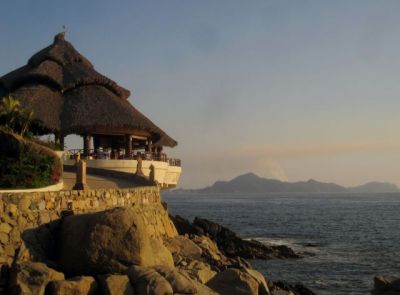


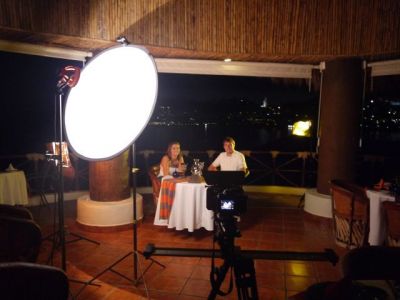





|
Recent Posts
famtripper fun fact
Notre-Dame Crypte Archeologique
At the far end of the parvis you can descend in the Crypte Archeologique. Here you’ll be able to see first hand the relics of an old Roman wharf, shops, houses and churches. There’s a lovely garden, which is located just outside. It's a great place to relax and watch the rollerbalders and people pass by.
Recent Topics
|










































